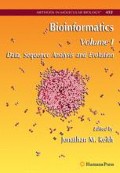Abstract
With the recent sequencing of numerous complete genomes and the advent of high throughput technologies (e.g., yeast two-hybrid assays or tandem-affinity purification experiments), it is now possible to estimate the ancestral form of protein interaction networks. This chapter combines protein interaction data and comparative genomics techniques in an attempt to reconstruct a network of core proteins and interactions in yeast that potentially represents an ancestral state of the budding yeast protein interaction network.
Access this chapter
Tax calculation will be finalised at checkout
Purchases are for personal use only
References
Uetz, P., Giot, L., Cagney, G., et al. (2000) A comprehensive analysis of protein-protein interactions in Saccharomyces cerevisiae. Nature 403, 623–627.
Gavin, A. C., Bosche, M., Krause, R., et al. (2002) Functional organization of the yeast proteome by systematic analysis of protein complexes. Nature 415, 141–147.
Giot, L., Bader, J. S., Brouwer, C., et al. (2003) A protein interaction map of Drosophila melanogaster. Science 302, 1727–1736.
Li, S., Armstrong, C. M., Bertin, N., et al. (2004) A map of the interactome network of the metazoan C. elegans. Science 303, 540–543.
Butland, G., Peregrin-Alvarez, J. M., Li, J., et al. (2005) Interaction network containing conserved and essential protein complexes in Escherichia coli. Nature 433, 531–537.
Pereira-Leal, J. B., Audit, B., Peregrin-Alvarez, J. M., et al. (2005) An exponential core in the heart of the yeast protein interaction network. Mol Biol Evol 22, 421–425.
Peregrin-Alvarez, J. M., Tsoka, S., Ouzounis, C. A. (2003) The phylogenetic extent of metabolic enzymes and pathways. Genome Res 13, 422–427.
Makarova, K. S., Aravind, L., Galperin, M. Y., et al. (1999) Comparative genomics of the Archaea (Euryarchaeota): evolution of conserved protein families, the stable core, and the variable shell. Genome Res 9, 608–628.
Harris, J. K., Kelley, S. T., Spiegelman, G. B., et al. (2003) The genetic core of the universal ancestor. Genome Res 13, 407– 412.
Kyrpides, N., Overbeek, R., Ouzounis, C. (1999) Universal protein families and the functional content of the last universal common ancestor. J Mol Evol 49, 413–423.
Deane, C. M., Salwinski, L., Xenarios, I., et al. (2002) Protein interactions: two methods for assessment of the reliability of high-throughput observations. Mol Cell Prot 1, 349–356.
Altschul, S. F., Gish, W., Miller, W., et al. (1990) Basic local alignment search tool. J Mol Biol 215, 403–410.
Goldovsky, L., Cases, I., Enright, A. J., et al. (2005) BioLayout (Java): versatile network visualisation of structural and functional relationships. Appl Bioinformatics 4, 71–74.
Pellegrini, M., Marcotte, E. M., Thompson, M. J., et al. (1999) Assigning protein functions by comparative genome analysis: protein phylogenetic profiles. Proc Natl Acad Sci U S A 96, 4285–4288.
Woese, C. (1998) The universal ancestor. Proc Natl Acad Sci U S A 9, 6854–6859.
Ouzounis, C. A., Kunin, V., Darzentas, N., et al. (2005) A minimal estimate for the gene content of the last common ancestor: exobiology from a terrestrial perspective. Res Microbiol 2005; Epub ahead of print.
Ouzounis, C. A. (2005) Ancestral state reconstructions for genomes. Curr Opin Genet Dev 15, 595–600.
Acknowledgments
The author thanks John Parkinson for reading the manuscript and making useful comments. This work was supported by the Hospital for Sick Children (Toronto, Ontario, Canada) Research Training Center.
Author information
Authors and Affiliations
Editor information
Editors and Affiliations
Rights and permissions
Copyright information
© 2008 Humana Press, a part of Springer Science+Business Media, LLC
About this protocol
Cite this protocol
Peregrín-Alvarez, J.M. (2008). Inferring Ancestral Protein Interaction Networks. In: Keith, J.M. (eds) Bioinformatics. Methods in Molecular Biology™, vol 452. Humana Press. https://doi.org/10.1007/978-1-60327-159-2_19
Download citation
DOI: https://doi.org/10.1007/978-1-60327-159-2_19
Publisher Name: Humana Press
Print ISBN: 978-1-58829-707-5
Online ISBN: 978-1-60327-159-2
eBook Packages: Springer Protocols

